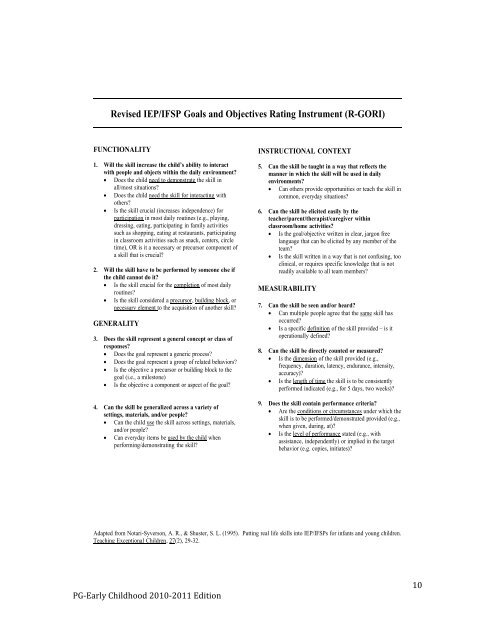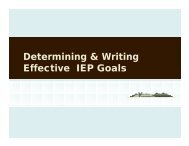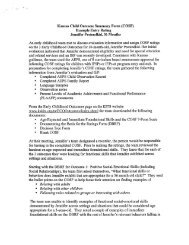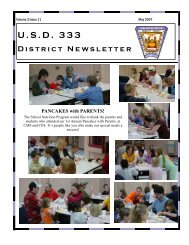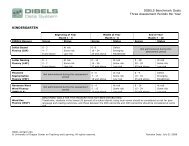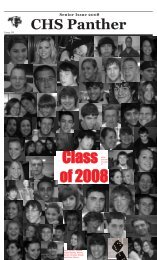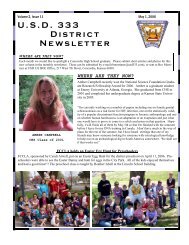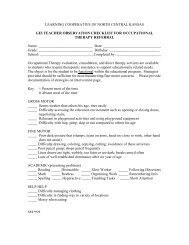Revised IEP/IFSP Goals and Objectives Rating Instrument ... - Usd 333
Revised IEP/IFSP Goals and Objectives Rating Instrument ... - Usd 333
Revised IEP/IFSP Goals and Objectives Rating Instrument ... - Usd 333
You also want an ePaper? Increase the reach of your titles
YUMPU automatically turns print PDFs into web optimized ePapers that Google loves.
<strong>Revised</strong> <strong>IEP</strong>/<strong>IFSP</strong> <strong>Goals</strong> <strong>and</strong> <strong>Objectives</strong> <strong>Rating</strong> <strong>Instrument</strong> (R-GORI)FUNCTIONALITY1. Will the skill increase the child’s ability to interactwith people <strong>and</strong> objects within the daily environment?• Does the child need to demonstrate the skill inall/most situations?• Does the child need the skill for interacting withothers?• Is the skill crucial (increases independence) forparticipation in most daily routines (e.g., playing,dressing, eating, participating in family activitiessuch as shopping, eating at restaurants, participatingin classroom activities such as snack, centers, circletime), OR is it a necessary or precursor component ofa skill that is crucial?2. Will the skill have to be performed by someone else ifthe child cannot do it?• Is the skill crucial for the completion of most dailyroutines?• Is the skill considered a precursor, building block, ornecessary element to the acquisition of another skill?GENERALITY3. Does the skill represent a general concept or class ofresponses?• Does the goal represent a generic process?• Does the goal represent a group of related behaviors?• Is the objective a precursor or building block to thegoal (i.e., a milestone)• Is the objective a component or aspect of the goal?4. Can the skill be generalized across a variety ofsettings, materials, <strong>and</strong>/or people?• Can the child use the skill across settings, materials,<strong>and</strong>/or people?• Can everyday items be used by the child whenperforming/demonstrating the skill?INSTRUCTIONAL CONTEXT5. Can the skill be taught in a way that reflects themanner in which the skill will be used in dailyenvironments?• Can others provide opportunities or teach the skill incommon, everyday situations?6. Can the skill be elicited easily by theteacher/parent/therapist/caregiver withinclassroom/home activities?• Is the goal/objective written in clear, jargon freelanguage that can be elicited by any member of theteam?• Is the skill written in a way that is not confusing, tooclinical, or requires specific knowledge that is notreadily available to all team members?MEASURABILITY7. Can the skill be seen <strong>and</strong>/or heard?• Can multiple people agree that the same skill hasoccurred?• Is a specific definition of the skill provided – is itoperationally defined?8. Can the skill be directly counted or measured?• Is the dimension of the skill provided (e.g.,frequency, duration, latency, endurance, intensity,accuracy)?• Is the length of time the skill is to be consistentlyperformed indicated (e.g., for 5 days, two weeks)?9. Does the skill contain performance criteria?• Are the conditions or circumstances under which theskill is to be performed/demonstrated provided (e.g.,when given, during, at)?• Is the level of performance stated (e.g., withassistance, independently) or implied in the targetbehavior (e.g. copies, initiates)?Adapted from Notari-Syverson, A. R., & Shuster, S. L. (1995). Putting real life skills into <strong>IEP</strong>/<strong>IFSP</strong>s for infants <strong>and</strong> young children.Teaching Exceptional Children, 27(2), 29-32.PG‐Early Childhood 2010‐2011 Edition10
Early Childhood Outcome <strong>and</strong> <strong>IEP</strong> Review Summary FormChild’s Name__________________________<strong>IEP</strong> Review Date_______________Outcome 1: To what extent does the child show age appropriate functioning , across a variety of settings<strong>and</strong> situations, in the area of social interaction?Involves:StrengthsAreas for growth• Relating with adults• Relating with otherchildren• For older children,following rules relatedto groups or interactingwith othersIncludes areas like:• Attachment/separation/autonomy• Expressing emotions<strong>and</strong> feelings• Learning rules <strong>and</strong>expectations• Social interactions <strong>and</strong>playOutcome 2: To what extent does the child show age appropriate functioning , across a variety of settings<strong>and</strong> situations, related to the acquisition <strong>and</strong> use of knowledge <strong>and</strong> skills?Involves:StrengthsAreas for growth• Thinking• Reasoning• Remembering• Problem solving• Using symbols <strong>and</strong>language• Underst<strong>and</strong>ing physical<strong>and</strong> social worldsIncludes:• Early concepts –symbols, pictures,numbers, classification,spatial relationships• Imitation• Object permanence• Expressive language <strong>and</strong>communication• Early literacyOutcome 3: To what extent does the child take action to meet his/her own needs as appropriate to his/herage across a variety of settings <strong>and</strong> situations?Involves:StrengthsAreas for growth• Taking care of basicneeds• Getting from place toplace• Using tools (e.g. fork,toothbrush, crayon)• In older children,contributing to their ownhealth <strong>and</strong> safetyIncludes:• Integrating motor skillsto complete tasks• Self-help skills (e.g.dressing, feeding,grooming, toileting,householdresponsibility)• Acting on the world toget what one wantsAdapted from : Nyl<strong>and</strong>er, D. (2010). Nyl<strong>and</strong>erAnnualReportECOWorksheet. Paper presented at the 2010 OSPE LeadershipMega Conference. Retrieved from http://leadershipmega‐confreg.tadnet.org/uploads/file_assets/attachments/228/original_Nyl<strong>and</strong>er_Annual_Report_w‐ECO_worksheet.pdf?1280160000PG‐Early Childhood 2010‐2011 Edition11


